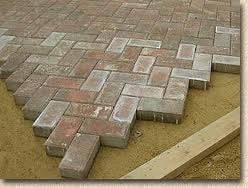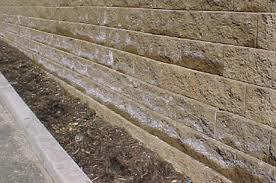The concrete industry calls it Efflorescence. It is a natural byproduct of the concrete manufacturing process.
 Efflorescence:
Efflorescence:
ef-flo-res-cence (ef∋ le res∋ens), 1. a change on the surface to a powdery substance upon exposure to air, as a crystalline substance through loss of water. 2. to become incrusted or covered with crystals of salt or the like through evaporation or chemical change.
Efflorescence is the stubborn problem that has caused confusion and trouble for the masonry and concrete industry since the first time it appeared thousands of years ago on ancient masonry walls. Efflorescence is normally the white, powdery scum that can appear on masonry walls after construction but can also be brown green or yellow, depending on the type of salts. Nobody likes it, nobody wants it on their walls or pavers, but occasionally this persistent problem appears.
 Great deals of time, money and effort have been spent trying to solve the difficulties efflorescence generates. Many test programs have been developed and numerous attempts have been made to eliminate the efflorescence problem. Unfortunately, nothing has proven 100% effective against this very stubborn problem. However, even though no surefire cure has been discovered, a great deal has been learned about how efflorescence works and how to prevent it, and if preventive measures are inadequate, how to remove the efflorescence if it does appear.
Great deals of time, money and effort have been spent trying to solve the difficulties efflorescence generates. Many test programs have been developed and numerous attempts have been made to eliminate the efflorescence problem. Unfortunately, nothing has proven 100% effective against this very stubborn problem. However, even though no surefire cure has been discovered, a great deal has been learned about how efflorescence works and how to prevent it, and if preventive measures are inadequate, how to remove the efflorescence if it does appear.
What is Efflorescence?
We know that efflorescence is a fine, white, powdery deposit of water-soluble salts left on the surface of masonry as the water evaporates. These efflorescent salt deposits tend to appear at the worst times, usually about a month after the project is constructed, and sometimes as long as a year after completion.
Required Conditions:
Efflorescence is not a simple subject. Three conditions must exist before efflorescence will occur.
- First: There must be water-soluble salts present somewhere in the wall.
- Second: There must be sufficient moisture in the wall to render the salts into a soluble solution.
- Third: There must be a path for the soluble salts to migrate through to the surface where the moisture can evaporate, thus depositing the salts which then crystallize and cause efflorescence.
All three conditions must exist. If any one of these conditions is not present, then efflorescence cannot occur.
This article is courtesy of masonryinstitute.org.
Related Articles:
The top 7 Problems and Solutions of Interlocking Concrete Pavers
How to Choose a GOOD Contractor